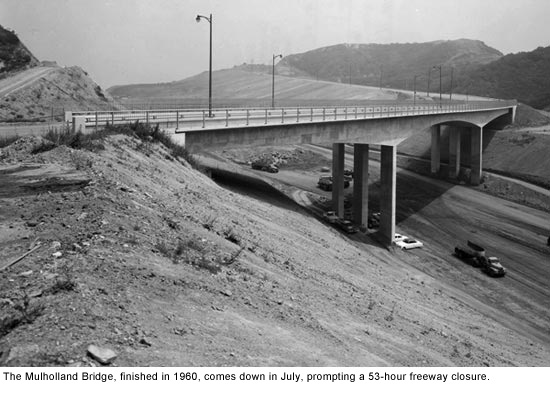Plan now for huge summer 405 closing
May 17, 2011
Los Angeles, you’ve already lived through plenty—from detours to demolition—as the 405 Sepulveda Pass project carves out a 10-mile northbound carpool lane between the Westside and the San Fernando Valley.
Well, you ain’t seen nothing yet.
After a couple of hours of demolition prep work beginning at 10 p.m. on July 15, the 405 Freeway will be closed in both directions—from Getty Center Drive to the 101—for 53 straight hours so that the south side of the Mulholland Bridge can be demolished. The freeway will be closed all of Saturday and Sunday, and will not reopen until 5 a.m. on Monday, July 18.
Updated 5/27/11: The latest plans call for the 405 Freeway to be closed northbound from the 10 Freeway to the 101. The southbound freeway will be closed from the 101 to the Getty Center Drive offramps. Full details are here.
With a half million or so vehicles moving along that stretch of the 405 during a typical July weekend, the closure has the potential of becoming a midsummer night’s nightmare for motorists heading to LAX, the beach or other destinations. But, with enough planning and advance notice, Metro officials say that the worst can be averted.
“This is manageable as long as the public cooperates. They’ve got a lot of summer plans and we don’t want them to be surprised,” said Metro spokesman Marc Littman. “If you can stay home, great. If you don’t have to drive, great.” And if you do have to get behind the wheel, follow the officially marked detours, which by that point will have been widely publicized.
Already, Metro is gearing up for a major blitz to raise public awareness of what will almost certainly be one of the project’s most disruptive weekends. (The other will come when the freeway is closed again for the demolition of the north side of the bridge some 11 months after.) Ads in local newspapers are expected to start running next week, and a press conference—the first of many outreach activities— is scheduled for May 23.
Getting out the word is a big job, given the magnitude of the closure, which may be the largest of its kind through such a heavily traveled stretch of freeway. “I think this is bigger than anything in memory,” Littman said.
In an email to elected officials Thursday, Metro CEO Art Leahy cited the 1984 Olympics—when Los Angeles streets and freeways moved amazingly well, despite widespread predictions of gridlock and other traffic horrors—as an example of how the region can get through a major transportation headache, given enough early warning.
The 1960 Mulholland Bridge is one of three bridges being demolished and rebuilt during the project. Demolition work on the Sunset and Skirball bridges took place over a series of nights, and was managed without such a lengthy closure of the entire freeway. In the case of the Mulholland Bridge, officials say its steepness makes the weekend-long closure necessary to protect passing motorists.
In addition to the 10-mile carpool lane and the modernized bridges, the $1.034 billion project also is widening underpasses, building 18 miles of sound and retaining walls, and creating new or improved ramps, including new “flyover” ramps at Wilshire Boulevard.
“There’s short-term pain, but long-term gain,” Littman said.
Posted 5/13/11













 405 bridge work causes a stink
405 bridge work causes a stink

